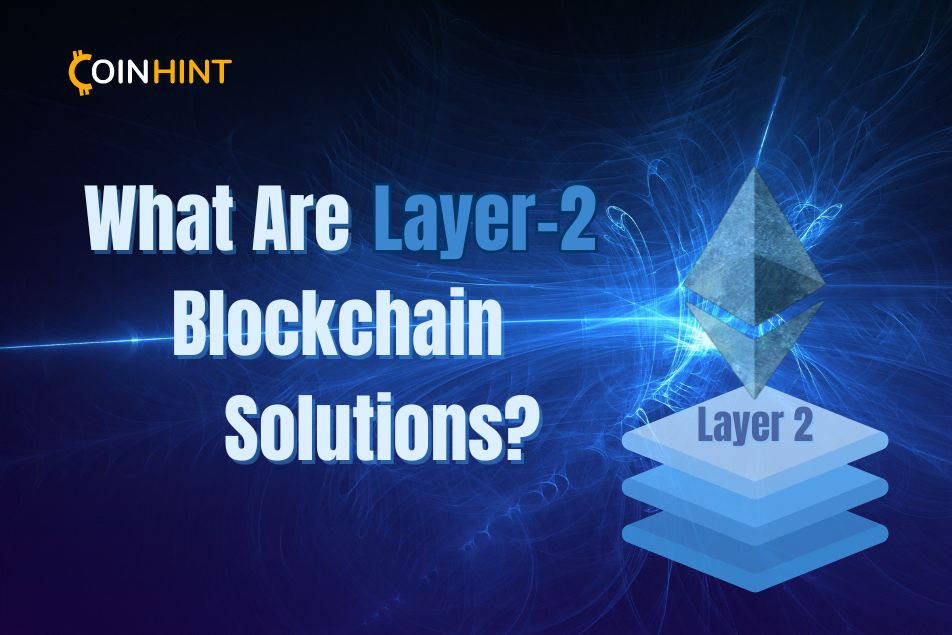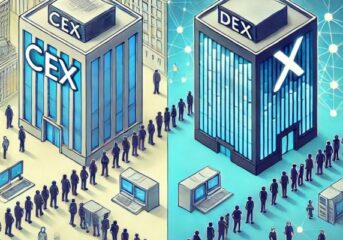- What Are Layer-2 Blockchain Solutions?
- Key Features of Layer 2 Solutions
- Why Is Layer 2 Security Important?
- How Do Layer 2 Solutions Work?
- Types Of Layer-2 Solutions
- Benefits Of Layer-2 Solutions
- Disadvantages Of Layer-2 Solutions
- Examples Of Popular Layer-2 Scaling Solution
- Case Studies of Layer-2 Scaling
- The Future of Layer 2 Solutions
- FAQ's
Layer-2 Solutions Explained: A Complete Guide
Read this guide to understand layer-2 blockchain solutions. Find out what they are and their role in addressing the scalability issue in the blockchain industry. Get an in-depth overview of the various types of layer-2 solutions and see how they have developed. Learn about their advantages and disadvantages and explore some key examples of the most popular layer-2 blockchain scaling solutions currently available.
- What Are Layer-2 Blockchain Solutions?
- Key Features of Layer 2 Solutions
- Why Is Layer 2 Security Important?
- How Do Layer 2 Solutions Work?
- Types Of Layer-2 Solutions
- Benefits Of Layer-2 Solutions
- Disadvantages Of Layer-2 Solutions
- Examples Of Popular Layer-2 Scaling Solution
- Case Studies of Layer-2 Scaling
- The Future of Layer 2 Solutions
- FAQ’s

What Are Layer-2 Blockchain Solutions?
Layer 2 (L2) blockchain solutions, also known as scaling solutions, are a set of secondary solutions built on top of an existing blockchain, often referred to as a layer-1 or primary blockchain. It is important to understand that these layer-2 solutions are intended to address issues associated with leading networks such as Bitcoin and Ethereum, which offer high levels of security and decentralization but compromise on scalability.
Layer-2 solutions enhance the capability of the primary chain by processing most transactions off-chain, leaving only the main blockchain for settlement. This increases transaction speeds, reduces costs, and vastly increases scalability while leveraging the security of the main chain.
Key Features of Layer 2 Solutions
- Greater scalability: They process more transactions than the primary layer 1 blockchains.
- Lower transaction fees: Layer-2 protocols enhance cost efficiency by reducing transaction fees, making it possible to make micro-transactions.
- Faster transactions: Layer-2 blockchains process and finalize transactions faster than the primary chain.
- Interoperability: Some layer-2 protocols are designed to work with different blockchain networks.
- Security: Layer-2 solutions operate while maintaining the security of the primary blockchain.
Why Is Layer 2 Security Important?
The security of layer-2 solutions is important since they operate outside the main chain. This approach offers significant advantages in terms of speed and cost. Layer-2 security is vital because it must protect user-related transactions and their functionality, which could put user funds or information at risk.
How Do Layer 2 Solutions Work?
Layer-2 solutions work in a way that adds computations and transactions to the main chain. For this to occur, the following takes place:
- A user initiates a transaction on the layer-2 network.
- This process occurs outside the blockchain, often in conjunction with other transactions.
- The layer-2 solution establishes the cryptographic validity of the transaction.
- This proof is shared with the primary or first-layer blockchain for verification.
- The main block verifies the proof of the off-chain transaction before completing it.
Types Of Layer-2 Solutions
State Channels
This type of layer-2 solution enables numerous transactions to take place off-chain and only allows the final stage of the transaction to be recorded on the main blockchain. State channels are most valuable in cases where numerous but relatively small orders are made between a specific group of participants. For instance, state channels can be used in micropayment systems or the gaming context.
Sidechains
A sidechain is an independent blockchain parallel to the principal chain connected via a two-way peg. Each sidechain can have its consensus mechanism and block parameters, enhancing the flexibility of functionality.
Plasma
Plasma is regarded as an umbrella for child chains that work on transactions but are synchronized to the main chain. Its purpose is to handle many DApps in a decentralized application ecosystem. Plasma chains can be described as ‘’sub-block chains,’’ the security guaranteed by the main chain, but they work on their own rules.
Rollups
Rollups combine many transactions into one on the main chain. There are two main types:
- Optimistic Rollups: This approach can clear many transactions quickly, but a challenging period is needed before conclusively completing the transactions.
- Zero-Knowledge (ZK) Rollups: In this method, the transaction details can be validated without displaying the data using cryptographic proofs. This offers increased privacy and security while increasing the computations required.
Benefits Of Layer-2 Solutions
Faster Transactions
Layer-2 solutions are primarily beneficial because they can increase transaction speeds when these transactions happen off the main chain. Unlike Ethereum, which can only process between 10 and 15 transactions per second, some layer-2 solutions can process thousands of transactions per second. This enhancement in speed makes blockchain technology more suitable for real-time world use and high-frequency trading.
Lower Fees
Layer-2 solutions cost a lot less due to less traffic congestion. This makes blockchain software more open to more demands and potential uses, reduces charges, and creates a viable economic model to drive mainstream blockchain usage and adoption.
Increased Throughput
Layer-2 solutions add significant capacity to blockchain networks. This enhancement provides capacity for additional complex applications and a greater variety of individuals without burdening the primary chain.
Disadvantages Of Layer-2 Solutions
Security Risks
Often, layer-2 solutions rely on the main chain’s security, which comes with new potential risks. Because of their complicated design, complex vulnerabilities or strategies can create opportunities for system exploitation.
Complexity In Implementation
Layer-2 solutions pose technical difficulties. Such complexity can cause development and integration problems, which can impact the product’s usability or security. Moreover, using Layer-2 solutions requires special knowledge since developers cannot just switch from Layer-1 solutions and start working on layer-2 solutions with the same ease.
Centralization Concerns
Some Layer-2 solutions are, in a way, centralized because they use fewer validators or operators. In other words, they go against what blockchain technology seeks to offer through decentralization and may create single points of failure.
Examples Of Popular Layer-2 Scaling Solution
- Bitcoin Lightning Network: This is a payment channel for clearing fast, low-cost Bitcoin transactions. It enables near-instant micropayments and has seen increasing usage, especially in locations where Bitcoin is used for regular purchases.
- Ethereum’s Optimism: It is an Optimistic Rollup solution for Ethereum, cutting gas fees and speeding up transaction time. DeFi applications that want users to enjoy more affordable fees are increasingly using it.
- Polygon (formerly Matic Network): An implementation of Layer-2 scaling solution for Ethereum based on both Plasma and PoS sidechains. It has become a platform for deploying Ethereum-compatible decentralized applications with lower costs.
- Arbitrum: It is another optimistic rollup for Ethereum that offers lower fees and faster transactions. Because of its compatibility with Ethereum and increased efficiency, it has attracted several large DeFi projects.
- zkSync: A ZK Rollup solution that calls for invisibility in scalability. It also has the advantage of affording higher levels of privacy in transactions.
Case Studies of Layer-2 Scaling
Example 1: Ethereum’s layer-2 Scaling
Many blockchain-based applications have been developed on the Ethereum platform, currently second by market capitalization. During high traffic, the transaction fee for an Ethereum transaction can go up to the stars. However, this has been solved by layer-2 solutions such as Optimism and Arbitrum.
For instance, the number of transactions of Uniswap, which is one of the largest DEXs influentials based on the Optimism rollup network, significantly dropped its transaction fees. They could trade tokens for less than $1 in fees, while on the Ethereum mainnet, it would take hundreds of dollars to go through congested periods. This has made decentralized finance (DeFi) accessible to more people in the network.
Due to the success of Arbitrum and Optimism, a significant proportion of Ethereum’s transactions happen on layer-2. This optimizes the user experience not only for those using layer-2 networks but also for those stuck in the congestion of Ethereum’s main network.
Example 2: Bitcoin Lightning Network
Lightning Network is one of the most famous solutions for layer-2 scaling. It allows users to transfer Bitcoin in real time using average transaction fees. This has been especially true in places such as El Salvador, where Bitcoin is now legal tender.
Implementing the Lightning Network in El Salvador has allowed small businesses to accept Bitcoin payments without stressing over high transaction charges or long confirmation waits. For instance, a person selling goods on the streets may sell a cup of coffee using Bitcoin, which was not possible on the main Bitcoin network since fees would be high and the time taken to confirm such a transaction would be very lengthy.
The Lightning Network is not unique to El Salvador alone. Cryptocurrency exchanges have already adopted it to help Bitcoin withdrawals and deposits become faster and less expensive. It has also unlocked new use cases for Bitcoin micropayments, creating streaming sats (small fractions of a Bitcoin) for content consumption.
The Future of Layer 2 Solutions
The future of layer-2 solutions is bright as the team continues to develop. Key trends include:
- Interoperability: This is achieved by developing solutions that run on multiple blockchains. This can create a social fabric of the blockchain environment and enable easy transfer of assets and data between other networks.
- Improving User Experience: This is achieved by unveiling or simplifying layer-2 solutions for the end user. Over time, these solutions should be easy to implement for the average user, with user-friendly interfaces that do not require the user to deal directly with the complexity of layer-2.
- Integration with DeFi and NFTs: This is achieved by exploring new application areas for Layer-2 in decentralized finance and NFT markets. This could open the door to more efficient and cheaper DeFi solutions and NFT markets.
- Regulatory considerations: As layer-2 solutions rise, they will likely attract regulators’ attention. This may lead to new rules and regulations regarding compliance and greater legitimacy and acceptance.
- Technological advancements: Further research into better and more secure layer-2 protocols. These include improved use of zero-knowledge proofs, data compression improvements, and smart blockchain content management approaches.
Final Thoughts
Layer-2 protocols mark an advanced development in the blockchain ecosystem. They aim to solve scalability issues such as decentralization, security, and density. Layer-2 solutions have inherent drawbacks, but the advantages they offer, such as faster transactions, lower costs, and density, are significant for adopting blockchain technology.
As these solutions evolve, new and inspiring applications are created using layer-2. This means that some use cases previously impossible due to the cost of processing thousands of transactions per second become feasible.
However, our CoinHint team would caution that certain drawbacks should be considered when adopting layer-2 solutions. They bring additional complexity and potential security issues that must be addressed as the technology advances. In addition, layer-2 solutions are becoming a hot topic among developers, businesses, and users in the blockchain industry. As the ecosystem expands, layer-2 solutions are also crucial in defining the outcomes of decentralized applications and blockchain solution services.
The promising results of layer-2 options can be a crucial feature in promoting blockchain technology. By solving the scalability issues that plague most blockchain applications, layer-2 solutions pave the way for the creation of more powerful, faster, and more convenient blockchain-based systems.
It is important to note that layer 1 blockchains remain relevant and fundamental to cryptocurrencies and blockchains, providing the necessary infrastructure for layer-2 to emerge and drive blockchain adoption and development. Over time, these technologies have great potential to fully realize the potential of blockchain technology across a wide range of industries and applications.
FAQ
-
Are layer-2 solutions secure?
Layer-2 solutions are generally secure, but they create new security concerns. While they rely on the security of the foundational blockchain, they also have their own security measures.
-
What is the difference between layer-1 and layer-2?
Layer-1 is the foundational blockchain architecture to which layer-2 solutions are added to make blockchain solutions faster and more efficient. Layer-1 is devoted to the fundamental structure of blockchain, and layer-2 aims to improve layer-1.
-
Which layer of blockchain technology is most important?
Both layer-1 and layer-2 are important for different specialties. Layer-1 is the fundamental security and decentralization level, while layer-2 adds scalability and practicality. In other words, importance is relative in that it depends on the application of the tool or the dataset needed.
-
What is the most popular layer-2 blockchain?
The most used Layer-2s are Lightning for Bitcoin and Optimism and Arbitrum for Ethereum. However, popularity is not unconditional and can quickly change in blockchain solutions and their adoptions.
-
What is a common example of a layer-2 scaling solution?
The Lightning Network, used for Bitcoin, is a typical example of layer-2 scaling. It allows for fast Bitcoin transactions. It links various parties and creates payment channels by sharing micropayment paths between them, which can enable mutual settlements on the main Bitcoin network.








